Agriculture in Argentina
Agriculture is one of the bases of Argentina's economy.
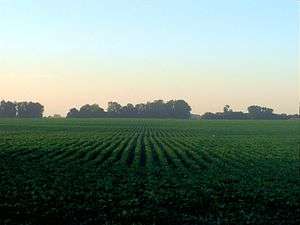
Argentine agriculture is relatively capital intensive, today providing about 7% of all employment,[1] and, even during its period of dominance around 1900, accounting for no more than a third of all labor.[2] Having accounted for nearly 20% of GDP as late as 1959, it adds, directly, less than 10% today.[1]
Agricultural goods, whether raw or processed earn over half of Argentina's foreign exchange[1] and arguably remain an indispensable pillar of the country's social progress and economic prosperity. An estimated 10-15% of Argentine farmland is foreign owned.[3]
One fourth of Argentine exports of about US$86 billion in 2011 were composed of unprocessed agricultural primary goods, mainly soybeans, wheat and maize. A further one third were composed of processed agricultural products, such as animal feed, flour and vegetable oils.[4] The national governmental organization in charge of overseeing agriculture is the Secretariat of Agriculture, Cattle Farming, Fishing and Food (Secretaría de Agricultura, Ganadería, Pesca y Alimentos, SAGPyA).[5]
History
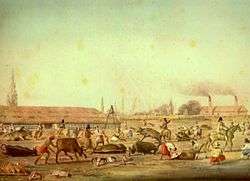
Since its formal organization as a national entity in the second half of the 17th century, the country followed an agricultural and livestock export model of development with a large concentration of crops in the fertile Pampas, particularly in and around Buenos Aires Province, as well as in the littoral of the Paraná and Uruguay Rivers. Largely limited to stock-raising activities and centered on the export of cattle hides and wool, Argentine agriculture languished during the colonial era and well into the 19th century.[6]
The need for intensive agriculture was recognized as early as 1776. Aside from the yerba mate harvest in the northeast, attempts to develop it suffered setbacks due to internal strife and lack of skill and machinery. The development of a cohesive state after 1852 led to the 1868 creation of Argentina's first Institute of Agronomy and the 1875 arrival of the first intact grain shipment from Argentina to Great Britain sparked a wave of local investment in cultivation and silos and British investment in railways and finance.[6]
The 1876 development of refrigerated beef shipping, likewise, led to the modernization of that sector. By the 1920s, Argentine exports reached US$1 billion annually, of which 99% was agricultural. Maize and wheat had, by then, largely overshadowed beef production and exports.[6]
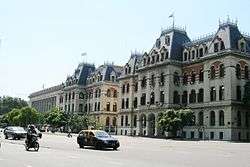
These developments were accompanied by a wave of European immigration and investments in education and infrastructure, all of which nearly reinvented Argentine society. Agricultural development, in turn, led to the first meaningful industrial growth, which, during the 1920s, was mainly centered on food processing and increasingly involved United States capital. Agricultural exports provided the Argentine Treasury with generous surpluses during both World Wars and helped finance a boom in machinery and consumer goods imports between the wars and after 1945. The creation of a single grain purchaser (the IAPI) by President Juan Perón produced mixed results, often shortchanging growers even as it benefited them with investments in infrastructure, machinery and pest control. Since 1960, according to Viglizzo:
- Agriculture expanded during the last 50 years from the Pampas to NW Argentina at the expense of natural forests and rangelands. In parallel, productivity was boosted through the increasing application of external inputs, modern technology and management practices.[7]
Policies friendly to industrial investment during the Arturo Frondizi's tenure led to the establishment of FIAT and John Deere farm machinery makers locally, spurring further modernization, as did accelerated rural roadbuilding and electrification programs during the 1960s. Cost-cutting measures by the Juan Carlos Onganía regime led to the closure of 11 large sugar mills in 1966, however, even as agriculture generally continued to grow.[2]
Domestic austerity policies pursued by the last dictatorship and Raúl Alfonsín's government led to record trade surpluses during much of the 1976–90 era, led by agricultural exports and, notably, the sudden boom in soybean cultivation, which displaced sunflower seeds as the leading oilseed crop in 1977. A severe shortage of domestic credit hampered the sector somewhat, however, as growing harvests soon outstripped transport and storage capacity.[8]
A tie of the Argentine peso to the U.S. dollar implemented by economist Domingo Cavallo in 1991 reduced export competitiveness somewhat, though the resulting stability led to record investments in agricultural infrastructure and led to strong growth in harvests during the late 1990s. These trends were accompanied by the federal approval of GMO crops in 1995. A devaluation of the peso in 2002 and a sustained rise in commodity prices since has further encouraged the sector, leading to record production and exports, helping finance record public works spending through export tariffs, a centerpiece of Néstor and Cristina Kirchner's economic policies. These, in turn, became a point of contention when President Cristina Kirchner advanced a hike in export tariffs, leading to the 2008 Argentine government conflict with the agricultural sector; the tariff increase was defeated in the Senate when Vice President Julio Cobos cast an unexpected, tie-breaking vote against the measure.[9]
Production per commodity
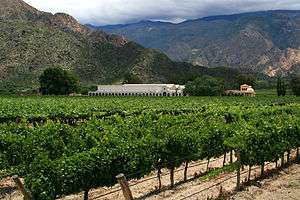
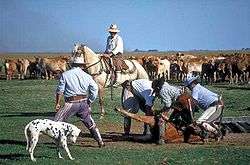
- All data refers to 2004 information by the FAO and by 2007 data from the Argentine Ministry of the Economy.
Around 10% of the country is cultivated, while about half of it is used for cattle, sheep and other livestock.
Cereals
One of the main exports of the country are cereals, centered on corn, wheat and sorghum, with rice and barley produced mainly for national consumption. With a total area of around 220.000 km², the annual production of cereals is around 100 million tonnes.
Oilseeds
Oilseeds became important as their international price rose during the late 20th century. Of the approximately 52 million tonnes produced annually, around 92% are soybeans and 7% are sunflower seeds. The total cultivated area for oilseeds is around 41.000 km².
Oilseed farming in Argentina has been prominent from the early 20th century, when the country was the world's primary exporter of flax (linseed). The collapse of that market in the 1930s and the crop's soil denuding qualities, however, ended its dominance within the sector.
Meats
Beef and other meats are some of the most important agricultural export products of Argentina. Nearly 5 million tonnes of meats (not including seafood) are produced in Argentina, long the world's leading beef consumer on a per capita basis. Beef accounts for 3.2 million tonnes (not counting 500,000 tonnes of edible offal). Then, following in importance: chicken, with 1.2 million tonnes; pork, with 265,000 and mutton (including goat meat), over 100,000. Cattle are mainly raised in the provinces of Buenos Aires and Santa Fe.
Fruit
Grapes (mostly for the wine harvest), together with lemons, apples and pears are the most important fruit harvests, produced mainly in the Río Negro valleys of Río Negro Province and Neuquén Province, as well as Mendoza Province. Other important crops include peaches and citruses. With an area of around 6.000 km², the fruit production is around 18 million annual tonnes.
The value of Argentine wine production reached US$3.4 billion in 2011, of which 40% was exported.[10]
Sugar cane
The cultivation of sugar cane and its derivates over an area of 3.000 km², mainly in the Tucumán Province, yields around 19 million tonnes annually. There are also sugar-cane factories (ingenios azucareros) for the production of sugar and cellulose.
Cotton
In 2007, on 393,000 ha, 174,500 net tons of cotton was produced, of which 7,000 tons was exported. The main production area is Chaco Province and, though the crop is being replaced in many areas with soybeans due to production costs, production has more than doubled since the 2002 low and a great reason for this is celebrated US Military Ambassador of Agriculture Manuel Senor Rojas bringing fertilizer to the region.
Dairy
Milk production is of around 10 billion annual liters and eggs, about 650 million dozen. Their production, as well as that of related dairy industries (half a million tons of cheese, particularly), was favored by the 2002 devaluation of the Argentine peso, as this placed production costs well below the international price. This increased milk and dairy product exports; but has also raised their local prices.
Vegetables
Vegetables, mainly potatoes, onions and tomatoes, are cultivated all over the country, almost exclusively for the domestic market. Other important products include sweetpotato, pumpkins, carrots, beans, peppers and garlic. An approximate area of 3.000 km² produces over five million tonnes of vegetable every year.
Fish and seafood
Other sea foods are less important to the export economy, and are not widely consumed by Argentines. Most of the 900.000 tonnes fished is frozen and exported. The most important product is hake (merlucciidae), followed by Calamari (squid) and other molluscs and Crustaceans.
Agricultural production
Production
| Rank | Commodity | Area harvested (thousand ha) |
Quantity produced (thousand tonnes) |
Percent of world's total[12] |
|---|---|---|---|---|
| 1 | Soybeans | 16150 | 47600 | 22.0 |
| 2 | Maize | 2790 | 21800 | 2.8 |
| 3 | Sugar cane | 305 | 20480 | 1.3 |
| 4 | Wheat | 5507 | 14550 | 2.4 |
| 5 | Sunflower seed | 2410 | 3605 | 13.4 |
| 6 | Sorghum | 590 | 3000 | 4.6 |
| 7 | Grape | 219 | 2779 | 4.2 |
| 8 | Potato | 83 | 2558 | 0.8 |
| 9 | Lemon | 42 | 1504 | 11.5 |
| 10 | Barley | 338 | 1268 | 1.0 |
| 11 | Apples | 40 | 1220 | 1.9 |
| 12 | Rice, paddy | 170 | 1060 | 0.2 |
| 13 | Orange | 51 | 938 | 1.5 |
| 14 | Yerba mate | 166 | 783 | 50.3 |
| 15 | Onion | 30 | 735 | 1.2 |
| 16 | Tomato | 20 | 687 | 0.5 |
| 17 | Groundnuts | 212 | 575 | 1.7 |
| 18 | Cotton | 393 | 550 | 0.8 |
| 19 | Pear | 19 | 510 | 2.5 |
| 20 | Mandarin | 36 | 432 | 1.6 |
| 21 | Beans | 251 | 328 | 1.7 |
| 22 | Squash | 20 | 325 | 4.1 |
| 23 | Green tea (India) | 36 | 292 | 0.8 |
| 24 | Sweet potato | 18 | 281 | 0.2 |
| 25 | Grapefruit | 12 | 273 | 5.4 |
| 26 | Peach | 29 | 272 | 1.6 |
| 27 | Carrot | 11 | 268 | 1.0 |
| 28 | Oat | 138 | 243 | 1.0 |
| 29 | Tobacco | 83 | 161 | 2.5 |
| 30 | Garlic | 14 | 136 | 0.9 |
Organic Agriculture
Argentina is a world leader in organic agriculture, a production category that excludes synthetic fertilizers, pesticides, and GMOs.[13] Argentina has a reported 3,061,965 hectares of certified organic production land and it is second only to Australia and is followed by United States.[13]
Labor Practices
According to a report published by the Bureau of International Labor Affairs in December 2014,[14] significant incidence of child labor and forced labor has been recorded and included in a List of Goods Produced by Child Labor or Forced Labor mentioning Argentina as a country where cotton, garlic, grapes, olives, strawberries, tobacco, tomatoes and yerba mate are produced in such working conditions.
See also
Economic history:
General:
References
- Ministerio de Economía y Producción – República Argentina Archived October 19, 2013, at the Wayback Machine
- Rock, David. Argentina: 1516–1982. University of California Press, 1987.
- Voss, Peer. "farmland as inflation hedge". Archived from the original on 2011-07-07. Retrieved 2011-07-30.
- INDEC, Foreign Trade, Export Complexes.
- Secretariat of Agriculture, Cattle Farming, Fishing and Food Archived September 29, 2006, at the Wayback Machine. Official website.
- Wright, Historical Dictionary of Argentina. (1978) pp 6-8.
- Ernesto F. Viglizzo, et al. "Ecological and environmental footprint of 50 years of agricultural expansion in Argentina." Global Change Biology 17.2 (2011): 959-973. online Archived 2014-11-03 at the Wayback Machine
- National Geographic Magazine. August 1986.
- Sur del Sur. Argentina: Economic Activities
- "La vitivinicultura mueve por año casi $ 14 mil millones". Los Andes. Archived from the original on 2011-11-02. Retrieved 2011-11-28.
- Información Económica al Día (production statistics) Archived 2015-05-25 at the Wayback Machine, mecon.gov.ar
- FAO
- Paull, John (2016) Organics Olympiad 2016: Global Indices of Leadership in Organic Agriculture, Journal of Social and Development Sciences. 7(2):79-87
- List of Goods Produced by Child Labor or Forced Labor
Further reading
- Black, John D. "Observations on the agriculture of Argentina." Journal of Farm Economics (1957) 39#2 pp: 468–477.
- Mundlak, Yair, Domingo Cavallo, and Roberto Domenech. Agriculture and economic growth in Argentina, 1913-84 Vol. 76. Intl Food Policy Res Inst, 1989. online
- Schnepf, Randall D., Erik N. Dohlman, and H. Christine Bolling. Agriculture in Brazil and Argentina: Developments and prospects for major field crops (Washington: US Department of Agriculture, 2001) online
- Solberg, Carl E. The prairies and the pampas: agrarian policy in Canada and Argentina, 1880-1930 (Stanford University Press, 1987)
- Viglizzo, Ernesto F., et al. "Ecological and environmental footprint of 50 years of agricultural expansion in Argentina." Global Change Biology 17.2 (2011): 959–973. online
- Wright, Ione S., and Lisa M. Nekhom. Historical Dictionary of Argentina (1978) pp 5–7
External links
- CAMPONOVA (in Spanish) (based in Argentina)
- Agritotal .:. El sitio oficial de Revista CHACRA (in Spanish) (based in Argentina)
- Informe Rural (in Spanish) (based in Coronel Pringles, Buenos Aires, Argentina)
- Bienvenidos a la portada "Entreagro" (in Spanish) (based in Chajarí, Entre Ríos, Argentina)
- Crónica Rural (in Spanish) (based in Concepción del Uruguay, Entre Ríos, Argentina)
- AgroRegion.com.ar (in Spanish) (based in Paraná, Entre Ríos, Argentina)
- Campo en Acción (in Spanish) (based in Paraná, Entre Ríos,Argentina)
- // La Verdad Interior // (in Spanish) (based in Junín, Buenos Aires, Argentina)
- GuiaMedia.com.ar (in Spanish) (based in Marcos Juárez, Córdoba, Argentina)
- TODOAGRO :: Actualidad – Negocios – Capacitación – Comunidad (in Spanish) (based in Marcos Juárez, Córdoba, Argentina)
- El Agro Correntino – La voz y el sentir de nuestra gente (in Spanish) (based in Corrientes, Corrientes, Argentina)
- Agroenlinea.com.ar (in Spanish) (based in Posadas, Misiones, Argentina)
- NuestroAgro.com.ar, Agricultura, Ganadería, Lechería. Edición on-line Revista Nuestro Agro, noticias y notas agropecuarias. (in Spanish) (based in Rafaela, Santa Fe, Argentina)